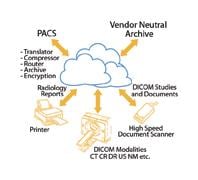
Medweb is one of the companies offering a cloud-based PACS.
(Links to more recent related articles and videos are at the bottom of this story)
A picture archiving and communication system (PACS) comprises a multitude of different devices working together to eliminate the use of physical films generated by different imaging modalities by digitizing them. This brings ease and convenience in the economical storage and transmission of these digital images, as the need to file, retrieve or transport the physical films is eliminated.
With ever-increasing costs and price sensitivity, the need to reduce costs is as important as ever. PACS vendors are trying to provide scalable, high-quality systems with flexible configurations while providing cheaper hardware and software support. This is achieved by shifting data from a traditional onsite storage and archiving system to the cloud storage principle.
Cloud computing, in lay terms, is similar to accessing one’s e-mail from Gmail or Yahoo! Mail, as all of the data is remotely stored at a secure location, without worrying about the storage capacity or failure of a local system. The data can be tailored as per the needs of the end-user from any location and through any system after the provision of the appropriate password.
The first large-scale PACS installation was at the University of Kansas in 1982. PACS technology today has evolved from storing and archiving solutions, to department-based solutions and enterprise-wide image management solutions. PACS system evolution is reflected by the growth in the market value, from $679.4 million in 2009 to a projected value of $1.35 billion by 2016, with a compound annual growth rate of 10.3 percent in Europe.
The Strengths of Cloud-Based PACS
Manufacturers are realizing benefits of this technology and slowly incorporating it into their new-generation radiology information system (RIS) or PACS system by software as a service (SAAS) model. Thus, there is an immediate reduction in the cost of the storage and archiving for the hospital, clinic or imaging center, since there is no longer a need for investing in these areas. Absence of an onsite data center reduces the ancillary investments that would be associated in running it, such as the emergency power backup or uninterruptible power supply (UPS), as well as the heating, ventilation and air conditioning (HVAC) systems. An offsite data center managed by the vendor puts the responsibility of data backup, disaster protection and recovery responsibility on it.
There is a further reduction in overall costs, since technology management for IT systems is outsourced to IT experts. With the absence of many systems, valuable square footage is saved that can be utilized by the hospital or clinic to set up more beds and accommodate more patients.
Due to the presence of hardware and system components at the vendor’s data center, there should be a greater degree of responsiveness. The response times for maintenance services can be drafted into the initial contract with the vendor at the time of purchase, ensuring appropriate system redundancy in order to fulfill the terms and conditions. This can be a huge bonus for facilities that lack dedicated IT personnel.
PACS solutions provide flexibility to physicians and radiologists to access medical records (even from systems other than the hospital’s) while they are away from the hospital, with the only requirement being an Internet connection. Considering the significant reduction in investment with respect to new systems and the workload of the radiologist and the PACS administrator, such cloud systems allow professional healthcare experts to concentrate their main attention on medical cases to provide better care to patients.
Apart from economic benefits and provision of better quality care, PACS also can help to reduce the carbon footprint. With the reduction in the overall number of hardware equipment pieces, there should be a lower amount of energy demanded in the production, running, cooling and, ultimately, disposing of these systems.
With lower energy demands, there also would be a reduction in the relative carbon dioxide emission, helping the organization as a whole adopt a “greener” stance in its operation.
Challenges With a Cloud System
Despite the benefits, the adoption of cloud-based systems is not easy. The presence of a reliable, high-speed, bandwidth Internet connection is the most important factor when considering such systems, as it is the operational backbone. Hence, it is important that the Internet connection have several redundancies. Speed and bandwidth should be considered when setting up such a system, as the speed of accessing and downloading medical images from the online archive should be within acceptable limits, even when several different users are accessing the “data cloud” simultaneously.
Cloud-based PACS with offsite data centers hold data security of utmost importance. Strict third-party checks and audit trials are required in order to ensure that these data centers are secure in storing medical data and capable of maintaining confidentiality. The medical data for any patient can be subdivided into three categories, explained below:
• General details — This comprises general patient details, such as name, age, sex, blood group, etc. This also may include highly confidential details, such as medical insurance, bank account and personal home address information.
• Medical images and surgery data — This includes medical images that might be taken at pre-operative or post-operative times when the patient was admitted to the hospital.
• Research data — In some cases, the patient might be suffering from some rare and peculiar symptoms currently under analysis. In this example, the patient may have a medical condition that requires consent for research. These consent documents would be stored under medical research data.
Currently, hospitals and healthcare providers may be interested in the cloud-based systems; however only medical images, surgery data and research data are uploaded onto an online data cloud. The patient’s highly sensitive general details are mostly kept in onsite data storage devices. Despite using the modern Health Insurance Portability and Accountability Act (HIPAA) enforcement rules and Health-Level 7 (HL7) transmission protocols, there is still a level of fear and apprehension when putting medical data in the cloud.
For hospitals interested in such systems, it might not be possible currently to transfer large amounts of data or even to change their cloud service provider. Such systems are still in their infancy, with business models yet to be developed on a larger scale. Thus, there is apprehension about adopting a new system, such as cloud-based PACS.
There might also be problems in terms of bureaucratic barriers in some countries, as it is illegal to actually send medical data outside the premises of the hospital or transmit the medical data to individuals not employed by the hospital. Thus, there is a huge barrier that does not allow the data to be stored at the offsite data center that may not always be within the country, with the concept of outsourcing some of the hospital IT duties.
Future Opportunities Include Physician Collaboration
As with any new technology, there are initially some road blocks and general inertia of the market towards adopting something that is completely new. Even though the concept of cloud computing might still be in its infancy and is not without flaws, it does promise many gains in the long run for healthcare service providers as well as patients.
Some of the players in the market, such as Carestream Health, Candelis and Securad, to name a few, have already started offering cloud-based PACS services. With the evolution and widespread adoption of cloud-based services, it would be possible to set up a global forum wherein physicians from across the world using those services could share their experiences and, to a certain extent, patient symptoms. This would help to provide a better consult and obtain a third opinion on a particular medical case. (It would be similar to the Vue Cloud Community already offered by Carestream Health in its Vue cloud-based PACS.)
Another consideration are the companies that provide teleradiology services by outsourcing medical images after the consult of the primary radiologist to a secondary radiologist sitting on the other side of the globe. This reduces the workload on an individual radiologist and also could improve the level of patient care, as a tired radiologist in the United States could share results of a particular medical case in the evening with a radiologist in India. Owing to the time difference between the two countries (night time in the United States is still daytime in India), an alert and fresh radiologist could be better able to read a medical image than a tired one. Hence, it is necessary to properly evaluate the needs of the hour and take a pragmatic approach towards the slow and steady adoption of cloud-based PACS systems.
Related Enterprise Imaging Content
RSNA Technology Report 2015: Enterprise Imaging
VIDEO: Creating an Enterprise Imaging System
Strategy is Key to Enterprise Imaging Success
Deconstructing PACS in Developing Enterprise Imaging
What is Vendor Neutral Anyway?
An Ounce of VNA Strategy is Worth a Pound of Remediation
Users Will Determine Whether Enterprise Imaging Succeeds
Deconstructing PACS: Point/Counterpoint
Enterprise Imaging Will Help Industry Achieve Patient-centric Care
Understanding Enterprise Imaging
Editor's Note: Rohan Panda is a Frost & Sullivan Healthcare Research Associate, focusing on healthcare IT, patient monitoring and medical imaging. Frost & Sullivan’s Growth Partnership Service provides the CEO and the CEO’s Growth Team with disciplined research and best-practice models to drive the generation, evaluation and implementation of powerful growth strategies. For more information: www.frost.com.



 April 11, 2024
April 11, 2024 








